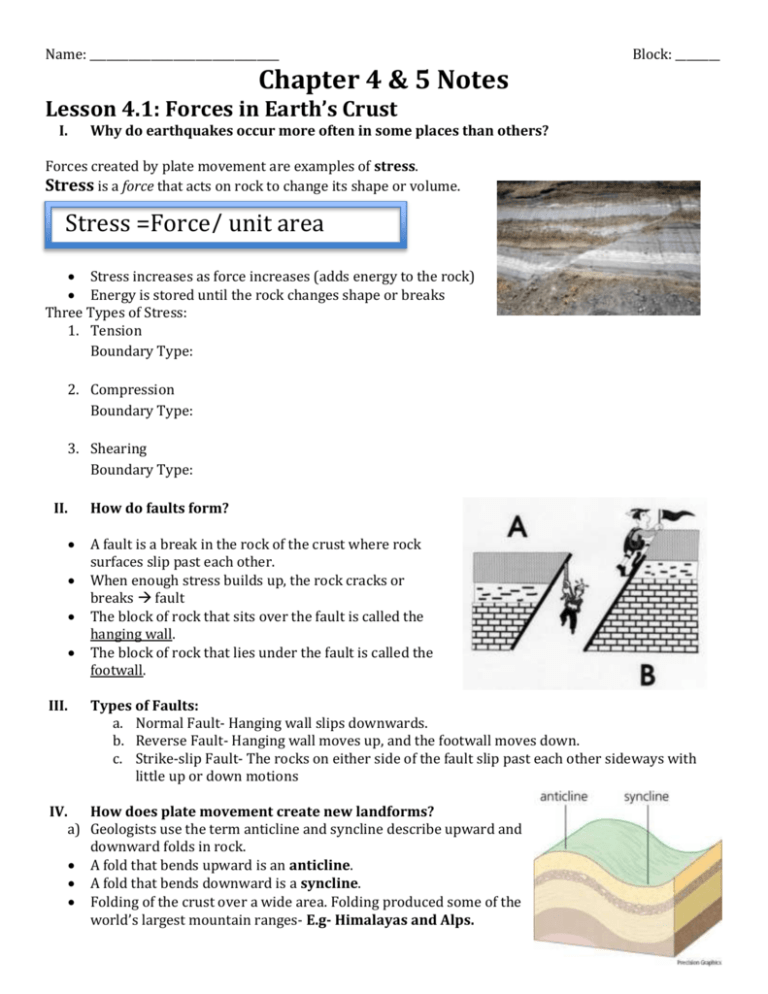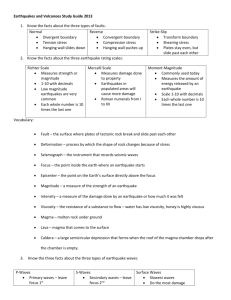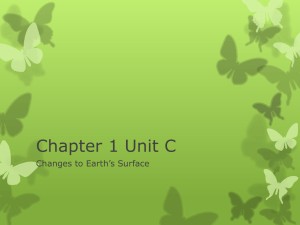File
advertisement

Name: __________________________________ Chapter 4 & 5 Notes Block: ________ Lesson 4.1: Forces in Earth’s Crust I. Why do earthquakes occur more often in some places than others? Forces created by plate movement are examples of stress. Stress is a force that acts on rock to change its shape or volume. Stress =Force/ unit area Stress increases as force increases (adds energy to the rock) Energy is stored until the rock changes shape or breaks Three Types of Stress: 1. Tension Boundary Type: 2. Compression Boundary Type: 3. Shearing Boundary Type: II. III. IV. How do faults form? A fault is a break in the rock of the crust where rock surfaces slip past each other. When enough stress builds up, the rock cracks or breaks fault The block of rock that sits over the fault is called the hanging wall. The block of rock that lies under the fault is called the footwall. Types of Faults: a. Normal Fault- Hanging wall slips downwards. b. Reverse Fault- Hanging wall moves up, and the footwall moves down. c. Strike-slip Fault- The rocks on either side of the fault slip past each other sideways with little up or down motions How does plate movement create new landforms? a) Geologists use the term anticline and syncline describe upward and downward folds in rock. A fold that bends upward is an anticline. A fold that bends downward is a syncline. Folding of the crust over a wide area. Folding produced some of the world’s largest mountain ranges- E.g- Himalayas and Alps. Name: __________________________________ Block: ________ b) Stretching and uplifting the Earth’s Crust Fault-Block Mountain- Mountains that form from tension in Earth’s crust that causes two normal faults cause valleys to drop down on either side of the block of rock. o E.g- The Great Basin Plateau- a large area of flat land elevated high above sea level. Wider than it is tall. o E.g.- The Kaibab Plateau of the Grand Canyon Lesson 4.2: Earthquakes and Seismic Waves I. Why do earthquakes occur more often in some places than in others? An earthquake is the shaking and trembling that results from movement of rock beneath Earth’s surface. * Most are too small to notice, but some can crack open the ground and cause great damage. II. What are Seismic Waves? Seismic Waves- are vibrations that are similar to sound waves. They travel through Earth carrying energy released by an Earthquake. III. Earthquakes start below the surface of the Earth. An earthquake's seismic waves carry energy up toward the surface and down through the interior. The speed and path of waves depends on the material through which it travels. Types of Seismic Waves * Focus- the area beneath Earth’s surface where rock that was under stress begins to break or move. *Epicenter- the point on the surface directly above the focus. Most Earthquakes start in the Lithosphere. P-waves- seismic waves that compress and expand the ground like an accordion. S-waves- seismic waves that can vibrate from side to side or up and down. o Cannot travel through liquids Surface waves (L-waves)- move more slowly than P and S waves, but can produce severe ground movements. Can make the ground roll like ocean waves. Name: __________________________________ Block: ________ IV. How are Earthquakes Measured? Seismograph- an instrument that records and measures an eq’s seismic waves. Modified Mercalli Scale- ranks the amount of shaking from an EQ (1 to 12) rated by people’s observations. The Richter Scale - rate the magnitude of small earthquakes based on the size of the eq’s waves as recorded by seismographs. • Magnitude- a # that geologists assign to an earthquake based on the Earthquakes size. V. How is an epicenter located? *Geologists use seismic waves to locate an Earthquake’s epicenter* P waves arrive at the seismograph first b/c they are faster S waves arrive second The farther away an Earthquake is from the epicenter, the GREATER the time between arrival of P waves and S waves. Must use 3 stations to determine the epicenter. Use a compass to see where three circles intersect. Lesson 4.3: Monitoring Earthquakes I. How do seismographs work? *Seismographs- complex electronic devices used to detect and record seismic waves. Consists of a heavy weight attached to a frame by a spring or wire. A pen connected to the weight rests it point on a drum that can rotate. Seismograph’s drum vibrates which causes pen (which stays in one spot) to record drum’s vibrations as back and forth squiggles Seismogram- the pattern of lines recorded by a seismograph o The height of the line drawn by the seismograph is greater for more severe EQ. II. What patterns do seismographic data reveal? Used to monitor Earthquakes Show where Earthquakes occur around the world Frequency of Earthquakes at plate boundaries. a) Earthquake risk in North America Depends how close you are to a plate boundary. b) Earthquake risk around the world Many of the Earth’s earthquakes occur in a vast area of geologic activity called the Ring of Fire. Plate boundaries form a ring around the Pacific Ocean also find volcanoes here. Name: __________________________________ Lesson 5.1: Volcanoes and Plate Tectonics Block: ________ I. How does a volcano erupt? A volcano is a mountain that forms in Earth’s crust when molten material, or magma, reaches the surface. Magma- a molten mixture of rock-forming substances, gases, and water from the mantle. o When magma reaches the surface it is called lava. Volcano belts from along the boundaries of Earth’s plates. o Volcanoes can occur where two plates pull apart, or diverge. o Volcanoes can also occur where two plates converge. o The Ring of Fire is one major belt of volcanoes that circles the Pacific Ocean. Diverging Boundaries o Under water at mid-ocean ridges o On land large volcanoes are found along the Great Rift Valley in East Africa Converging Boundaries a) When two oceanic plates converge older, denser material sinks into the mantle to from a deep ocean trench o Sometimes rising magma forms chains of islands in the middle of the ocean called island arcs. b) When an oceanic plate converges with continental plate denser oceanic crust subducts o Volcanoes of the Andes Mountains and South America o In the US plate collision produced volcanoes in the Pacific Northwest Mt. St. Helens Mount Rainier c) Hot Spots- areas where material from deep within Earth’s mantle rises through the crust and melts to form magma. o A volcano forms above a hot spot o Hot spots stay in one place for millions of years, while the plate moves over them. Can be found along plate boundaries In the middle of plates (Yellowstone National Park in Wyoming and the Hawaiian Islands) Name: __________________________________ Lesson 5.2: Volcanic Eruptions Block: ________ I. What Happens When a Volcano Erupts? Inside a VOLCANO: a system of passageways through which magma moves. MAGMA CHAMBER: area beneath surface where magma collects. During an eruption magma forces its way through one or more cracks in Earth’s crust. PIPE: long tube that extends from Earth’s crust up through the top of the volcano, connecting the magma chamber to Earth’s surface. Magma moves upwards through the pipe VENT: opening where gas and magma exit the volcano LAVA FLOW: the spread of lava as it pours out the vent CRATER: a bowl- shaped area that may form at the top of a volcano around the central vent. II. What happens during a Volcanic Eruption? a) Force of pressurized dissolved gases in the in the magma chamber expand through the pipe to the surface until it flows or explodes out through the vent. Gas dissipates and lava escapes b) Types of Volcanic eruptions *Silica is a material found in magma that forms from the elements oxygen and silicon. Helps determine how fluid, or runny magma is.* Quiet: magma is HOT or LOW in silica o Flows easily for many kilometers o Pahoehoe Lava: forms from fast moving hot-lava that is thin and runny o Aa Lava: forms from lava that is cooler, thicker, and slow-moving o Most found in the Hawaiian Islands Explosive: HIGH water content and HIGH in silica o Thick and sticky magma- plugs up the pipe and builds pressure until it explodes o The erupting gases and steam push the magma out of the volcano with incredible force o Eruption throws lava into the air where it breaks into fragments that quickly cool and harden (smallest: volcanic ash/ larger: bombs) III. What are Hazards of Volcanoes? *Both quiet and explosive eruptions can cause damage* Fires Lava covers land and turns to rock Dangerous mixtures of hot rock and ash explode PYROCLASTIC FLOW- a fast moving cloud that rushes down the sides of the volcano o Contains hot gas, ash, cinders, and bombs Landslides of mud, snow, and rock Human, plant, and animal death Name: __________________________________ Block: ________ IV. What are the Stages of Volcanic Activity Activity may last from a decade to more than 10 million years. Active: one that is erupting or has shown signs it may erupt in the near future. Dormant: “sleeping” volcano that scientists expect will become active in the future Extinct: “dead” volcano that is unlikely to ever erupt again. *Warning Signs* Tiltmeters detect slight surface changes in elevation and tilt caused by moving magma Monitor escaping gases Monitor small earthquakes that occur around the volcano Upward movement of magma Rising temperatures in underground water Lesson 5.3: Volcanic Landforms I. Why do volcanoes erupt? What landforms do Lava and Ash Create? Volcanic activity on and beneath Earth’s surface has built up Earth’s land areas and formed much of the ocean crust. o Shield volcanoes- wide, gently sloping mountain (In Hawaii, Mauna Loa volcano) o Cinder cone volcanoes- a steep, cone- shaped hill or small mountain (Paricutin in Mexico) o Composite volcanoes (i.e.- Stratovolcano)- tall, cone shaped mountains in which layers of lava alternate with ash. (Mt. Fuji in Japan) o Lava plateaus- thin, runny lava that floods the area and travels great distances before cooling and solidifying. Repeated floods of lava can form high, level plateaus. (the Columbia Plateau in Washington, Oregon, and Idaho) o Calderas- huge holes left by the collapse of volcanoes A lake can form, filling the hole If the volcano erupts again, a steep- walled cone may form in the middle. II. What Landforms Does Magma Create? VOLCANIC NECK: forms when magma hardens in a volcano’s pipe and the surrounding rock wears away. DIKES: magma that forces itself across rock layers hardens SILLS: magma that squeezes between horizontal rock layers hardens DOME MOUNTIANS: forms when uplift pushes a large body of hardened magma toward the surface. The hardened magma forces the layers of rock to bend upwards into a dome. Formed the Black Hills in SD BATHOLITHS: a mass of rock that forms when a large body of magma cools inside the crust. Core of many mountain ranges







